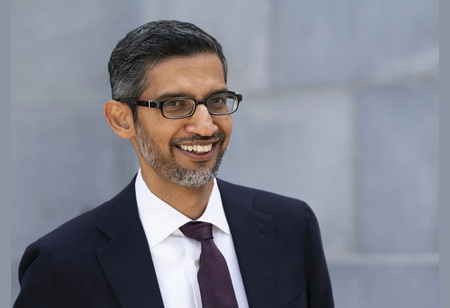
5 Astonishing Factors About Sundar Pichai's Leadership


There is a saying in Sanskrit that goes like this: Yata raja tata Praja. If leadership in a company is good, employees will follow in his footsteps. Hence, a leader should always be an inspiration to his teammates. It is also why leadership innovation and exemplary leadership strategies are essential for a leader to lead the team. Sundar Pichai's leadership is the epitome of this. The current CEO of Google is not only a trendsetter in the tech industry but also a great leader. He is a role model for people all around the world and a true inspiration for people seeking the best route to success. Here are some leadership lessons from Google’s CEO.
Being Ambitious
Sundar has been a technophile since his childhood, gifted with an amazing memory, which he has put to good use. Thanks to their upbringing and his parent's support and motivation toward pursuing an excellent academic career, Sunder was ambitious from the start. When he joined Google in 2004, he knew how to put the puzzle together after his time at McKinsey & Co. From the day Sundar joined the company as head of product management to the present day when he stands tall and firm as CEO; he has raised the bar on his goals higher and higher.
Sundar's career graph took a giant leap forward when he became Vice President of Product Management in 2008; he understood the need to democratize Google's search engine in 2008. He was also fiercely pursued by Twitter and was even expected to become CEO of Microsoft in 2011, but he chose to stay at Google. As a result, when the foundations of Google's parent company, Alphabet, were established in 2015, Sundar Pichai was unquestionably named the company's CEO.
Break Out of the Comfort Zone
Sundar is known for taking on some of the most challenging projects at Google. By successfully leading such projects, he demonstrated his ability to swim against the current scenarios. In the process, he earned the right to handle more projects, greater responsibility, and the power and status that comes with it.
Sundar's portfolio grew steadily from Chrome to Chrome OS, followed by Google Apps and then Android with Maps, Search, and Advertising. He started in product management and grew to handle a wide range of Google's offerings. He was able to do this only because he had mastered the art of prioritization. By prioritizing work, leaders achieve maximum productivity by leaving no work undone.
Embracing a Culture of Innovation
At the heart of Google's success is a culture of innovation, and Sundar has been instrumental in fostering this environment. He encourages his team to think outside the box, take risks, and embrace failure as a stepping stone to learning and improvement. Empowering employees to explore new ideas and try out breakthrough technologies has created a culture that thrives on innovation. Sundar’s commitment to innovation is evident in Google's significant investment in research and development (R&D). By devoting resources to cutting-edge technologies such as artificial intelligence, machine learning, and quantum computing, he ensures that Google remains at the forefront of technological advancement. This emphasis on research and development allows Google to continually launch groundbreaking products and services that are shaping the industry and transforming lives.
In an era of cutthroat competition and information overload, one needs to have a clear vision of the roadmap for the business and a plan for achieving its goals. Sundar stood on the shoulders of great leaders at Google and rose to become second-in-command because he was able to articulate direction better than others.
Sundar is known to have built, nurtured, and mentored a great team. His people development policy was based on meritocracy, and he spared no extra effort to ensure that his team's efforts were recognized and duly appreciated. A leader should put the team before self and rejoice in the success of the group. Sundar constantly inspires his team, which is filled with exceptional talent, through work ethic, professionalism, integrity, innovation, risk-taking insight, enthusiasm, and resourcefulness—traits that every organization expects from a leader.
The Hallmark of a Leader is the Urge to be Respected by the Team
Managing technology, product roadmaps, revenue, and human resources is a daunting task for any company. The pressure and stress are unimaginable. Sundar was a star cricket player as a student in India, excelling there and leading the state. His ability to manage stress can be traced back to this period when he played not to win but to be competitive, to cope with pressure, and to keep his body and mind agile. He must be practicing this trade in some form today to keep that momentum going. Leaders cannot avoid responsibility, but they must find ways to deal effectively with stress and pressure.
Sundar was adored by his team, loved by his marketing team, respected by his peers, valued by his superiors, sought after by his competitors, and welcomed by the market for his focused no-nonsense work ethic, and Googlers were happy and proud. The hallmark of a leader is the urge to be respected by his team, boss, peers, partners, customers, and even competitors.
Embracing Setbacks and Inspiring Youths
Despite his growing popularity and influence within the organization, Sundar kept a low profile. He is affable, approachable, and soft-spoken. Amidst the great challenges of his job, he took time to mentor students at his alma mater.
His repeated emphasis on the importance of learning from failure, the need to admit failure, and to take chances until you achieve, adds another lesson to his leadership repertoire.
“It's important to pursue your ambition and your heart. Do what makes you happy." With these words, he encourages young people to step out of their comfort zones, make difficult professional decisions, and take risks if necessary. It may take several efforts to reach the summit, but taking the first step and breaking out of the cocoon is important.

